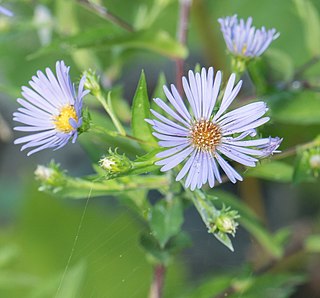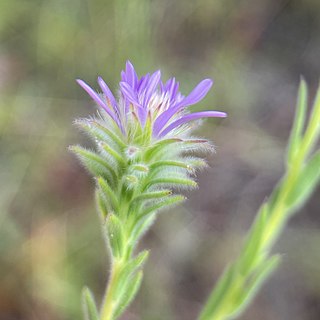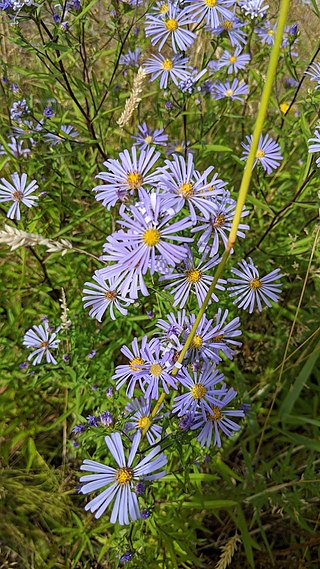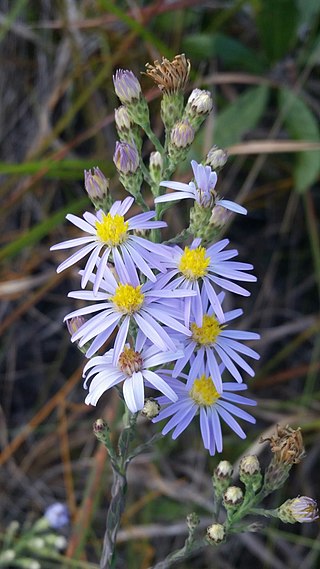
Symphyotrichum puniceum, is a species of flowering plant in the family Asteraceae native to eastern North America. It is commonly known as purplestem aster, red-stalk aster, red-stemmed aster, red-stem aster, and swamp aster. It also has been called early purple aster, cocash, swanweed, and meadow scabish.

Symphyotrichum ericoides, with common names white heath aster, frost aster, and heath aster, is a species of flowering plant in the family Asteraceae native to much of central and eastern North America. It has been introduced to parts of Europe and western Asia.

Symphyotrichum cordifolium, commonly known as common blue wood aster, heartleaf aster, and blue wood-aster, is a perennial herbaceous flowering plant in the family Asteraceae native to central and eastern North America. It reaches heights of up to 1.2 meters and has bluish daisy-like flowers which bloom late-summer and fall in its range.

Symphyotrichum defoliatum is a species of flowering plant in the family Asteraceae known by the common name San Bernardino aster. It is endemic to Southern California where it grows in grasslands and meadows, and it is of conservation concern.

Symphyotrichum pilosum is a perennial, herbaceous, flowering plant in the Asteraceae family native to central and eastern North America. It is commonly called hairy white oldfield aster, frost aster, white heath aster, heath aster, hairy aster, common old field aster, old field aster, awl aster, nailrod, and steelweed. There are two varieties: Symphyotrichumpilosum var.pilosum, known by the common names previously listed, and Symphyotrichumpilosum var.pringlei, known as Pringle's aster. Both varieties are conservationally secure globally and in most provinces and states where they are native.

Canadanthus is a North American monotypic genus of flowering plants in the family Asteraceae. The only species is Canadanthus modestus, commonly known as great northern aster or western bog aster. It is native to most of Canada and to northern parts of the United States.

Symphyotrichum falcatum is a species of flowering plant in the family Asteraceae. Commonly called white prairie aster and western heath aster, it is native to a widespread area of central and western North America.

Symphyotrichum shortii, commonly called Short's aster, is a species of flowering plant in the family Asteraceae. It is native to North America, where it is primarily found in interior areas east of the Mississippi River. Its natural habitat is in thin rocky soils of woodlands and thickets often around limestone bluffs. It is common throughout much of its range, although it is generally restricted to intact natural communities.

Symphyotrichum racemosum is a species of flowering plant native to parts of the United States and introduced in Canada. It is known as smooth white oldfield aster and small white aster. It is a perennial, herbaceous plant in the family Asteraceae. It is a late-summer and fall blooming flower.

Symphyotrichum drummondii is a species of flowering plant of the family Asteraceae native to the central and eastern United States. The common name Drummond's aster has been used for the species. There also is an accepted variety native to the south-central United States and northeast Mexico named S. drummondiivar. texanum. This variety has the common name of Texas aster. The species is a perennial, herbaceous plant that may reach 120 centimeters in height.

Symphyotrichum plumosum is a species of flowering plant in the family Asteraceae endemic to Florida in the United States. Commonly known as plumose aster, it is a perennial, herbaceous plant that may reach 40 to 100 centimeters tall. Its flowers have rose-purple ray florets and yellow turning to purple disk florets. It is of conservation concern.

Symphyotrichum porteri is a species of flowering plant in the family Asteraceae endemic to the foothills of the Rocky Mountains in the U.S. states of Wyoming, Colorado, and New Mexico. Commonly known as Porter's aster, it is a perennial, herbaceous plant that may reach 10 to 50 centimeters tall. Its flowers have white, rarely pinkish, ray florets and yellow, becoming pink then brown, disk florets. S. porteri grows at elevations of 1,800–2,900 meters. Its limited range makes it a NatureServe Vulnerable (G3) species, and it is classified Critically Imperiled (S1) in Wyoming.

Symphyotrichum retroflexum is a species of flowering plant in the family Asteraceae native to the southeastern United States. Commonly known as rigid whitetop aster, it is a perennial, herbaceous plant that may reach 40 to 100 centimeters tall. Its flowers have blue to purple ray florets and cream to pale yellow then pinkish disk florets. It is known only from the Blue Ridge Mountains in Alabama, Georgia, North Carolina, South Carolina, Tennessee, and Virginia, where it grows in wooded areas at elevations of 400–1,500 meters. As of September 2021, NatureServe classified it as Apparently Secure (G4); it had been reviewed last in 1994 and is marked as "needs review". There is an introduced presence of S. retroflexum in southeast China.

Symphyotrichum elliottii is a species of flowering plant in the family Asteraceae native to the southeastern United States Atlantic coastal plain where it grows in wetland areas. Commonly known as Elliott's aster, it is a perennial, herbaceous plant that may reach 6 to 20 decimeters tall. Its flowers have pink ray florets and pale yellow, then pink, then brown disk florets. NatureServe, as of July 2021, classified S. elliottii as Apparently Secure (G4) globally, and of conservation concern in North Carolina, South Carolina, and Virginia.

Symphyotrichum spathulatum is a species of flowering plant in the family Asteraceae native to western North America including northwestern Mexico. Commonly known as western mountain aster, it is a perennial, herbaceous plant that may reach 20 to 80 centimeters tall. Its flowers, which open in July and August, have violet ray florets and yellow disk florets.

Symphyotrichum subspicatum is a species of flowering plant in the family Asteraceae native to western North America. Commonly known as Douglas's aster, it is a perennial, herbaceous plant that may reach 40 to 120 centimeters tall. Its flowers have violet ray florets and yellow then reddish disk florets.

Symphyotrichum adnatum is a species of flowering plant in the family Asteraceae native to the southeastern United States and the Bahamas. It is a perennial, herbaceous plant that may reach 30 to 120 centimeters tall with flowers that have lavender ray florets and yellow disk florets. The common name scaleleaf aster has been used for this species.

Symphyotrichum chapmanii is a species of flowering plant in the family Asteraceae native to the Apalachicola River drainage basin of Alabama and Florida. Commonly known as savanna aster, it is a perennial, herbaceous plant that may reach 30 to 80 centimeters tall. Its flowers have purple to blue-lavender ray florets and pale yellow disk florets. It is a wetland species and is of conservation concern. It may be extirpated in Alabama.

Symphyotrichum divaricatum is an annual and herbaceous plant commonly known as southern annual saltmarsh aster. It is native to the southern United States and some northern states of Mexico.

Symphyotrichum kentuckiense is a rare species of flowering plant in the Asteraceae family and is commonly known as Kentucky aster, Price's aster, Miss Price's aster, Sadie's aster, or lavender oldfield aster. It is a perennial, herbaceous plant that is endemic to broken limestone cedar glades and roadsides in Alabama, Georgia, Kentucky, and Tennessee. It blooms from August through October, reaches heights between 30 centimeters and 100 cm (3.3 ft), and has green to reddish-brown stems. It is a nearly hairless plant with blue to blue-violet ray florets.





















